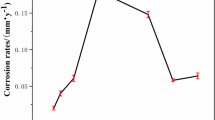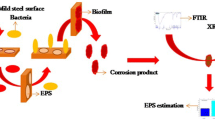Abstract
Corrosion in drinking water distribution systems (DWDSs) may lead to pipe failures and water quality deterioration; biocorrosion is the most common type. Chlorine disinfectants are widely used in DWDSs to inhibit microorganism growth, but these also promote electrochemical corrosion to a certain extent. This study explored the independent and synergistic effects of chlorine and microorganisms on pipeline corrosion. Sodium hypochlorite (NaOCl) at different concentrations (0, 0.25, 0.50, and 0.75 mg/L) and iron-oxidizing bacteria (IOB) were added to the reaction system, and a biofilm annular reactor (BAR) was employed to simulate operational water supply pipes and explain the composite effects. The degree of corrosion became severe with increasing NaOCl dosage. IOB accelerated the corrosion rate at an early stage, after which the reaction system gradually stabilized. When NaOCl and IOB existed together in the BAR, both synergistic and antagonistic effects occurred during the corrosion process. The AOC content increased due to the addition of NaOCl, which is conducive to bacterial regrowth. However, biofilm on cast iron coupons was greatly influenced by the disinfectant, leading to a decrease in microbial biomass over time. More research is needed to provide guidelines for pipeline corrosion control.

Similar content being viewed by others
References
Chen H, Tian Y, Guo H, Zhang H, Fu Y (2017). Effect of sodium hypochlorite on corrosion behavior of ductile cast iron pipe in reclaimed water. Corrosion Science & Protection Technology 29, 41–47
Firouzi A, Yang W, Shi W, Li C (2021). Failure of corrosion affected buried cast iron pipes subject to water hammer. Engineering Failure Analysis 120, 104993
Folkman S (2018). Water Main Break Rates in the USA and Canada: A Comprehensive Study. Utah State University: Buried Structures Laboratory. March. https://digitalcommons.usu.edu/mae_facpub/174/
Gerke T L, Maynard J B, Schock M R, Lytle D L (2008). Physiochemical characterization of five iron tubercles from a single drinking water distribution system: possible new insights on their formation and growth. Corrosion Science 50, 2030–2039
Gomes I B, Simões M, Simões L C (2014). An overview on the reactors to study drinking water biofilms. Water Research 62, 63–87
Gomez-Smith C K, LaPara T M, Hozalski R M (2015). Sulfate reducing bacteria and mycobacteria dominate the biofilm communities in a chloraminated drinking water distribution system. Environmental Science & Technology 49, 8432–8440
Han W(2014). Research on the pipe corrosion caused by iron bacteria in water distribution systems. Dissertation for the Mater Degree. Harbin: Harbin Institute of Technology
Hu Y, Dong D, Wan K, Chen C, Yu X, Lin H (2021). Potential shift of bacterial community structure and corrosion-related bacteria in drinking water distribution pipeline driven by water source switching. Frontiers of Environmental Science & Engineering, 15(2), 28
Jin J, Wu G, Guan Y (2015). Effect of bacterial communities on the formation of cast iron corrosion tubercles in reclaimed water. Water Research 71, 207–218
Li W, Tan Q, Zhou W, Chen J, Li Y, Wang F, Zhang J (2020). Impact of substrate material and chlorine/chloramine on the composition and function of a young biofilm microbial community as revealed by high-throughput 16S rRNA sequencing. Chemosphere 242, 125310
Li X, Wang H, Zhang Y, Hu C, Yang M (2014). Characterization of the bacterial communities and iron corrosion scales in drinking groundwater distribution systems with chlorine/chloramine. International Biodeterioration & Biodegradation 96, 71–79
Li X, Wang Y, Zhao H (2001). Effect of material quality of pipeline on quality of water supply. Journal of Harbin Institute of Technology 33, 592–595(in Chinese)
Li Y, Xu D, Chen C, Li X, Jia R, Zhang D, Sand W, Wang F, Gu T (2018). Anaerobic microbiologically influenced corrosion mechanisms interpreted using bioenergetics and bioelectrochemistry: A review. Journal of Mater Science & Technology 34, 1713–1718
Lytle D A, Magnuson M L, Snoeyink V L (2004). Effect of oxidants on the properties of Fe(III) particles and suspensions formed from the oxidation of Fe(II). Journal American Water Works Association 96, 112–124
Lytle D A, Tang M, Francis A T, O’Donnell A J, Newton J L (2020). The effect of chloride, sulfate and dissolved inorganic carbon on iron release from cast iron. Water Research 183, 116037
Ray R I, Lee J S, Little B J, Gerke T L (2010). The anatomy of tubercles: A corrosion study in a fresh water estuary. Materials and Corrosion 61, 993–999
Sachan R, Singh A K (2020). Comparison of microbial influenced corrosion in presence of iron oxidizing bacteria (strains DASEWM1 and DASEWM2). Construction and Build Materials 256, 119438
Sancy M, Gourbeyre Y, Sutter E M M, Tribollet B (2010). Mechanism of corrosion of cast iron covered by aged corrosion products: application of electrochemical impedance spectrometry. Corrosion Science 52, 1222–1227
Sarin P, Snoeyink V L, Bebee J, Kriven W M, Clement J A (2001). Physico-chemical characteristics of corrosion scales in old iron pipes. Water Research 35, 2961–2969
Sun H, Shi B, Lytle D A, Bai Y, Wang D (2014). Formation and release behavior of iron corrosion products under the influence of bacterial communities in a simulated water distribution system. Environmental Science: Process & Impacts 16, 576–585
Świetlik J, Raczyk-Stanisławiak U, Piszora P, Nawrocki J (2012). Corrosion in drinking water pipes: The importance of green rusts. Water Research 46, 1–10
Tang M, Nystrom V, Pieper K, Parks J, Little B, Guilliams R, Esqueda T, Edwards M (2018). The relationship between discolored water from corrosion of old iron pipe and source water conditions. Environmental Engineering Science 35, 943–952
Teng F, Guan Y, Zhu W (2008). Effect of biofilm on cast iron pipe corrosion in drinking water distribution system: Corrosion scales characterization and microbial community structure investigation. Corrosion Science 50, 2816–2823
Videla H A, Herrera L K (2009). Understanding microbial inhibition of corrosion. A comprehensive overview. International Biodeterioration & Biodegradation 63, 896–900
Wang H, Edwards M A, Falkinham J O 3rd, Pruden A (2013). Probiotic approach to pathogen control in premise plumbing systems? A review. Environmental Science & Technology 47, 10117–10128
Wang H, Hu C, Hu X, Yang M, Qu J (2012). Effects of disinfectant and biofilm on the corrosion of cast iron pipes in a reclaimed water distribution system. Water Research 46, 1070–1078
Wang H, Hu C, Li X (2015). Characterization of biofilm bacterial communities and cast iron corrosion in bench-scale reactors with chloraminated drinking water. Engineering Failure Analysis 57, 423–433
Wang H, Hu C, Zhang S, Liu L, Xing X (2018). Effects of O3/Cl2 disinfection on corrosion and opportunistic pathogens growth in drinking water distribution systems. Journal of Environmental Sciences 73, 38–46
World Health Organization (2017). Guidelines for drinking-water quality: fourth edition incorporating the first addendum. Geneva: WHO Press. https://www.who.int/publications/i/item/9789241549950
Xu X, Liu S, Smith K, Cui Y, Wang Z (2020). An overview on corrosion of iron and steel components in reclaimed water supply systems and the mechanisms involved. Journal of Cleaner Production 276, 124079
Yang F, Shi B, Gu J, Wang D, Yang M (2012). Morphological and physicochemical characteristics of iron corrosion scales formed under different water source histories in a drinking water distribution system. Water Research 46, 5423–5433
Zhang H, Tian Y, Kang M, Chen C, Song Y, Li H (2019). Effects of chlorination/chlorine dioxide disinfection on biofilm bacterial community and corrosion process in a reclaimed water distribution system. Chemosphere 215, 62–73
Zhang H, Zhao L, Liu D, Wang J, Zhang X, Chen C (2020). Early period corrosion and scaling characteristics of ductile iron pipe for ground water supply with sodium hypochlorite disinfection. Water Research 176, 115742
Zhang J, Li W Y, Wang F, Qian L, Xu C, Liu Y, Qi W (2016). Exploring the biological stability situation of a full scale water distribution system in south China by three biological stability evaluation methods. Chemosphere 161, 43–52
Zhang S, Tian Y, Guo Y, Shan J, Liu R (2021). Manganese release from corrosion products of cast iron pipes in drinking water distribution systems: Effect of water temperature, pH, alkalinity, SO42− concentration and disinfectants. Chemosphere 262, 127904
Acknowledgements
The authors are grateful for primary support from the National Natural Science Foundation of China (Grant No. 51979194).
Author information
Authors and Affiliations
Corresponding author
Additional information
Highlights
• The early corrosion process in the cast iron pipes was investigated.
• The increase of NaOCl (< 0.75 mg/L) accelerated the cast iron corrosion.
• Biocorrosion caused by IOB could be divided into three stages in the early stage.
• Synergistic and antagonistic effects exist between residual chlorine and IOB.
Supplementary Materials of
11783_2021_1506_MOESM1_ESM.pdf
Synergistic effects of sodium hypochlorite disinfection and iron-oxidizing bacteria on early corrosion in cast iron pipes
Rights and permissions
About this article
Cite this article
Li, W., Tian, Y., Chen, J. et al. Synergistic effects of sodium hypochlorite disinfection and iron-oxidizing bacteria on early corrosion in cast iron pipes. Front. Environ. Sci. Eng. 16, 72 (2022). https://doi.org/10.1007/s11783-021-1506-3
Received:
Revised:
Accepted:
Published:
DOI: https://doi.org/10.1007/s11783-021-1506-3




